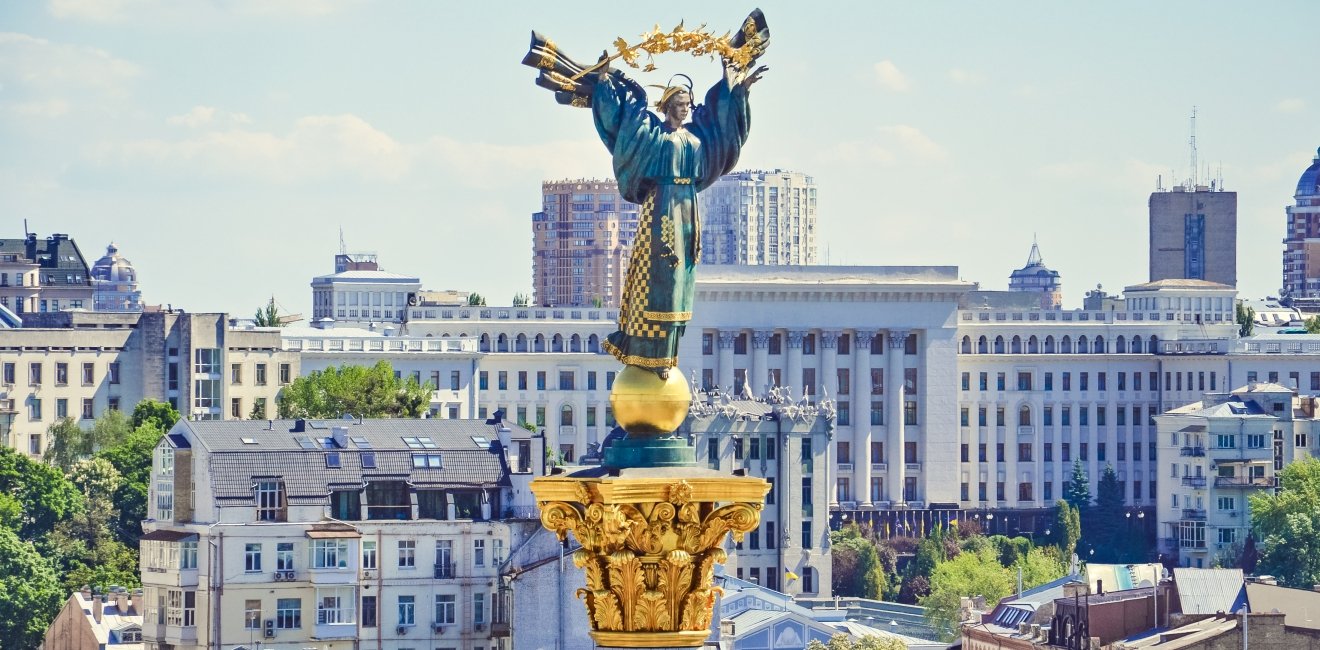
A blog of the Kennan Institute
BY MIKHAIL MINAKOV
Around thirty years ago the final phase of the Soviet Union’s dissolution got under way. The coup attempt launched by Soviet conservatives against President Mikhail Gorbachev and his reforms on August 18, 1991, had failed to control the government three days later, when it was aborted, but it did succeed in railroading the process for approving the new Union treaty. Despite a majority of Soviet citizens expressing support for a “renovated Union” in March 1991 polls (with 71 percent of those living in the socialist republic of Ukraine supporting it), the Soviet republican governments started preparing for the USSR’s dissolution by the end of August 1991.
The dissolution was guided by very different aspirations of the republican elites. Some wanted to strengthen their position in advance of expected negotiations to renew the Union treaty; others pursued the national communist agenda, trying to preserve their rule by distancing themselves from the too liberal Yeltsin’s Moscow; yet others saw an opportunity to establish independent nation-states. These aspirations can be seen in the texts of the declarations of independence that were approved by the republican Supreme Councils after Yeltsin emerged as the de facto leader after the coup attempt. The Ukrainian Declaration of independence, approved on August 24, 1991, is an example of the compromises that had to be reached among contending interests and hopes of the founders of contemporary Ukraine.
The practical steps entailed in dissolving the old Union and forming a new, independent state—a creative-destructive process—became more clearly visible in the decommunization efforts of 1991–1992. In Ukraine, from the end of August through December 1991, the Communist Party of Ukraine was dissolved, its property was nationalized, and the KGB was banned, while party and ideological pluralism was established and all individuals living on the soil of the Ukrainian socialist republic were granted citizenship in the emerging independent state. Unlike in many of the other socialist republics, these steps prevented civil conflict from breaking out. Ukraine’s national communists and national democrats had a consensus on establishing a new state, and no political force questioned it. The elites’ decision was supported by a referendum of December 1, 1991.
Now, thirty years later, it is not easy to find proper criteria by which to assess what has happened to us, the citizens of Ukraine, during this period. One place to start is by comparing what we have today with the expectations of those who established a new state in 1991.
These expectations are not an absolute point of reference, of course: 1991 marked a historical caesura, a profound change in the cultural, social, political, and economic life of many peoples living in Eastern Europe and northern Eurasia. The change was guided by hopes for the better, hopes that were shared equally among experts and citizenry, external observers and the people living through the transformative events. These boundless hopes almost inevitably spilled over into wishful thinking and political daydreaming.
Such wishful thinking appears to have guided the preparation of a famous report commissioned by Deutsche Bank to assess the prospects of the Soviet republics’ economic development in 1990.1 The report’s authors—a group of experts, led by Jürgen Corbet—expressed a mixture of truly prophetic vision and blindness to what was coming in the post-communist future. They did anticipate the USSR’s imminent dissolution but failed in their prediction that Ukraine would undergo the most successful economic transition of all the socialist republics and would “draw level with the economic and cultural standards of Western Europe.” The conclusions of this report were widely used in the campaign for Ukrainian independence and resonated with late Soviet Ukrainians’ aspirations regarding a possible future.
This mixture of hopes of 1991 can be assorted into three major tracks of the post-communist transformation: democratization, marketization, and Europeanization. Accordingly, I propose to assess the thirtieth anniversary of Ukraine’s independence on these tracks.
Democratization Track
Post-Soviet democratization implied the establishment of a nation-state, ideological pluralism, freedom of association and of the press, a multiparty system, free and fair elections, and a strong civil society. Thirty years of democratization have seen ups and downs on this track, but overall, Ukraine exists as a fully recognized independent and sovereign state. That sovereignty, however, has been threatened by the illegal annexation of Crimea, the continuous existence of non-government-controlled territories in the eastern Donbas, and ongoing military conflict in the Donbas.
Ukraine is one of the freest political regimes among the post-Soviet states, yet neither according to Freedom House reports nor according to Varieties of Democracy data can Ukraine be regarded as a full-fledged democracy. Rather, Ukrainian politics have oscillated between more and less free, hybrid political orders, with the best periods for liberal democracy in the first half of the 1990s and in 2005–2009. This uneven political development has provoked two deep political crises—the Orange Revolution of 2004 and the Euromaidan of 2013–2014—that put Ukraine’ existence as a country at risk. Despite a vibrant history of freedom of expression and debate in recent decades, in 2021 Ukrainians have also seen the authorities, including elected officials, take disturbing steps to limit such freedoms. The democratization track thus exhibits mixed achievements, with freedom and its opposite co-occurring and clashing in the continuing political transformation of Ukraine. It would be difficult to say the founding fathers’ and mothers’ dream of a free Ukrainian state and an open Ukrainian society has been fully realized.
Economic Track
Ukraine’s post-Soviet economic development has been guided by the goals of transformation toward a free market economy and a wealthy society.2 In pursuit of these goals, Ukrainians have experienced (and survived) the huge economic decline of the early 1990s, an economic growth spurt in 2002–2007, and unstable stagnation the rest of the time. The privatization process went quickly in the early post-Soviet years but was later put on hold by the newly created oligarchs. As in other post-Soviet nations, Ukrainians had to reinvent wealth and poverty, which created economic grounds for unstable politics and the rule of oligarchs. Marketization, the dream of 1991, is still incomplete, though the process continues, doggedly: only in 2020 did Ukraine finally launch its energy sector and agricultural land markets. And, like political liberty, economic freedom has oscillated between extremes. The slow pace of economic reforms, the dominance of the oligarchs in the economy, and ongoing war have kept Ukraine—despite some progress in human development and quality of life—among the poorest countries of Europe. In this respect, the dreamers of 1991 would definitely be disappointed with the results of Ukraine's economic development.
Europeanization Track
Finally, the Europeanization track has also brought many surprises. The heady dream of Eastern and Western Europeans coming together to create a single culturally and socially united region of peace and collaboration, which shined so brightly in 1989–1991, has been a strong motivation for the post-communist transformation. Regretfully, this dream has never been fully realized: Europe today is a geopolitically divided region experiencing a growing number of conflicts and antagonisms.
Unlike its Central European and Baltic neighbors, Ukraine did not always have European integration as a goal. A multivector foreign policy was more influential in 1991–2004 and again in 2010–2014, while European- (and U.S.-) oriented foreign policy was dominant (but also “declaratively dominant,” with declarations not followed by sufficient actions) in 2005–2009 and after the Euromaidan in 2014, which saw the ouster of the pro-Russia president Viktor Yanukovych and a decisive turn toward Europeanization among the citizenry, especially in the western portions of the country. Ukraine succeeded in gaining an Association Agreement with the EU in 2017, and that became the framework for some post-Euromaidan reforms. Today Ukrainian politicians and the government are in constant dialogue with their EU member-state peers. EU-Ukraine economic ties are strengthening. The security of Ukraine is now an important factor in the EU’s security. Millions of Ukrainian labor migrants are now part of European societies, while their remittances hugely support the Ukrainian economy. However, further integration with the EU is limited by obstacles posed by both Ukraine’s and the EU’s political and socioeconomic factors. While Europeanization—in the form of cooperation and integration with the EU—remains an important aspirational milestone for Ukraine, other developmental priorities may limit or even prevent it. Indeed, Ukraine has moved far ahead in becoming part of the European political, economic, and security agenda, yet I am not entirely sure that the forms of Ukraine’s Europeanization correspond to the intentions of the dreamers of 1991.
Whither the Dream?
The year 2021 is not the end of independent Ukraine’s history. I hope that in the future we will see more peace, freedom, and wealth in Ukraine and wider Europe. Yet my hope is constantly in conflict with the facts of what happened to the hopes of the founding fathers and mothers of Ukraine.
Notes
1. Jürgen Corbet et al., The Soviet Union at the Crossroads: Facts and Figures on the Soviet Republics (Frankfurt am Main: Deutsche Bank, 1990).
2. Tymofiy Mylovanov and Ilona Sologoub, “The Development of Ukraine’s Private Sector,” in From “The Ukraine” to Ukraine: A Contemporary History, 1991–2021, ed. Mikhail Minakov et al. (Stuttgart: ibidem-Verlag, 2021), 5394.
The opinions expressed in this article are those solely of the authors and do not reflect the views of the Kennan Institute.
Author


Kennan Institute
After more than 50 years as a vital part of the Wilson Center legacy, the Kennan Institute has become an independent think tank. You can find the current website for the Kennan Institute at kennaninstitute.org. Please look for future announcements about partnership activities between the Wilson Center and the Kennan Institute at Wilson Center Press Room. The Kennan Institute is the premier US center for advanced research on Eurasia and the oldest and largest regional program at the Woodrow Wilson International Center for Scholars. The Kennan Institute is committed to improving American understanding of Russia, Ukraine, Central Asia, the South Caucasus, and the surrounding region through research and exchange. Read more

Explore More in Focus Ukraine
Browse Focus Ukraine
Talking to the Dead to Heal the Living

Ukrainian Issue in Polish Elections


